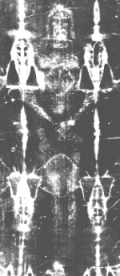Wanted: Man Willing To Be Crucified
Colorado Physicist Working To Solve
Mystery Of The Shroud
Wayne Harrison, Staff
Writer
July 27, 2001, 3:12 p.m. EDT
COLORADO SPRINGS, Colo. -- A Colorado
physicist is looking for a male volunteer, approximately the height
and weight of Jesus Christ, who is willing to be crucified.

John Jackson said that he will forgo using nails for
his research but the volunteer must be willing to be tied to large
cross.
Jackson operates The Turin Shroud Center of Colorado
and has been looking into the mysteries of the controversial shroud
for the past 27 years.
The shroud is a 14-foot-long piece of stained,
bloodied, slightly charred linen that believers say was the burial
cloth that wrapped the body of Jesus Christ.
Jackson, a former Air Force Academy and University of
Colorado professor, is one of 38 scientists from around the world
who were allowed to examine the shroud in 1978.

The Turin Shroud Center has everything but the shroud
itself, Jackson said: The controversial cloth has been under tight
wraps in a cathedral in Turin, Italy, since 1578. Instead, Jackson's
Center has a full-size color transparency of the shroud. Visitors
can also see two life-sized, styrofoam molds of crucified men, the
result of an experiment in which volunteers from the nearby Air
Force Academy hung on a cross to help Jackson analyze the blood flow
of a body during crucifixion. Two more styrofoam corpses lay wrapped
in burial cloth on the floor.
Jackson said that he still works part time as a
physics consultant on government defense projects, but it is the
shroud that consumes him. Jackson, a Catholic, said that his
religious beliefs permeate "everything I do in life." But his
beliefs don't compromise his research, he said.
Jackson said that he is undeterred by 1988
radiocarbon tests that dated the shroud at 600 to 700 years old,
rather than 2,000 years. Jackson has criticized the methodology used
in the tests and said that the results were skewed because the cloth
was slightly scorched in a 1532 fire.
In his 27 years of research, he's found no reason to
believe the shroud is not authentic. "That's because of research,
not because I want it to be so," he said.
Although he is reluctant to reveal the type of
research he is conducting, he said that he's trying to learn how a
human image could have been formed on the shroud, and is working on
experiments that he believes will show that the 1988 radiocarbon
test was inaccurate.
He said that he expects to have new results sometime
next year.
Additional Resources:
Copyright 2001 by NewsChannel2000.com. All
rights reserved. This material may not be published, broadcast,
rewritten or redistributed.
Regards,
Peter E Luke
~~~~~~~~~~~~~~~~~~~~~~~~~~~~
Diversions? Or what's really
happening?
http://groups.yahoo.com/group/Diversionz
~~~~~~~~~~~~~~~~~~~~~~~~~~~~ |